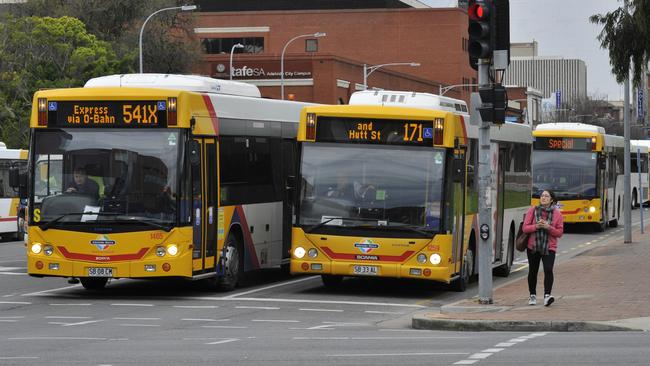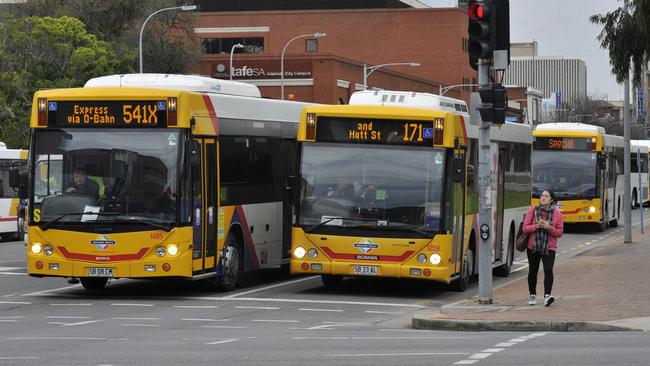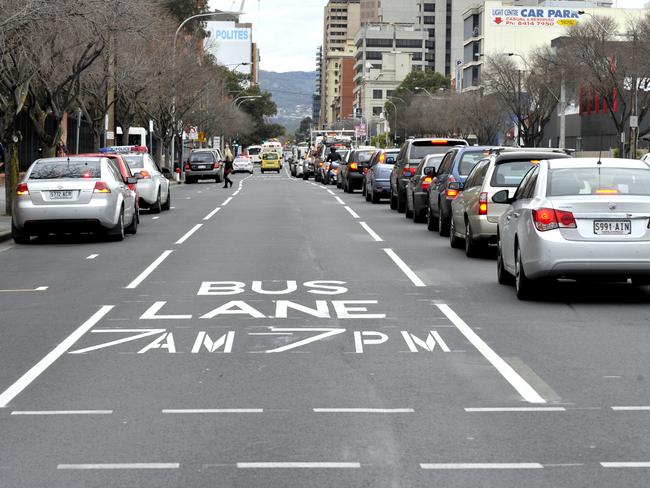CBD bus lanes designed to push cars out of the CBD
CITY bus lanes were designed to discourage motorists from driving into the CBD and push commuters on to public transport, secret documents have revealed.

SA News
Don't miss out on the headlines from SA News. Followed categories will be added to My News.
- Watch for new bus lanes — or cop $225 fine
- Why Adelaide’s priority bus lanes don’t work
- Adelaide’s city bus lanes hinder traffic, should be scrapped, says RAA
- Motorists slugged $70k for driving in bus lanes
- City councillors push for review into bus lanes
CITY bus lanes were designed to discourage motorists from driving into the CBD and push commuters on to public transport, secret documents have revealed.
Internal State Government documents, obtained by The Advertiser under Freedom of Information laws, shows bus lanes installed in the CBD aimed to reduce the number of motorists using the key city thoroughfares, to ensure buses were not delayed by traffic.
The bus lanes also risked increasing traffic congestion on other city roads as motorists changed their route and used parallel roads, according to the Transport Department documents.
They were introduced in July 2012, on Currie and Grenfell streets and West Tce to improve the efficiency of public transport services.
A government spokesman said priority bus lanes had increased the number of on-time services and improved network reliability.
“Contractors tell us that previously it could take them 20 minutes to traverse the length of the CBD travelling down Grenfell St,” he said.
“This has significantly improved since the introduction of these priority lanes.”
The traffic impact study undertaken for the bus lanes found they were “expected to cause congestion in the days following the implementation” as motorists adjusted to the changes but traffic would “eventually redistribute to alternate travel paths”.

The documents also show the State Government requested Adelaide City Council’s help to install the bus lanes in just two months after the policy was announced by Premier Jay Weatherill in May 2012.
The RAA has been critical in the past of the detrimental impact the bus lanes have had on traffic flows.
RAA spokesman Mark Borlace said the long-term trade-off was that a more efficient bus service created by the bus lanes would increase patronage and take cars off the road.
“But we still don’t know if more people are using these buses and it’s about time we did,’’ he said. “If it hasn’t, then we need to rethink how we use bus lanes.’’
The Maras Group managing director Steve Maras agreed that information was needed about the impact of the bus lanes on traffic flows.
“I think the jury is still out on where designated bus lanes would be and if any plans for more bus lanes,’’ the retail developer said.
“I would like to see an independent body investigate if there has been any increase in the bus patronage and how many cars are still using the roads.’’
Opposition transport spokesman David Pisoni said the documents showed the State Government hastily introduced the bus lanes without proper consideration on the overall traffic impacts.
“It is clear from these documents that Jay Weatherill’s bus lane plan was announced without due diligence and has created unnecessary difficulties for buses, cars and cyclists sharing these streets,” he said.

“The fact Labor’s city bus lane project was announced before any real thought had gone into how it would work shows just how lazy and arrogant this government has become.
“This isn’t Labor’s usual announce-and-defend style of government, more like announce and pray for the best.”
Another issue raised in the documents was that changing the road setup would require motorists to merge into the bus lane to turn left to side streets while travelling on Currie and Grenfell streets.
“The lanes were installed in the left traffic lane to cater for the mix of stopping buses travelling along the corridor that need to merge into the kerbside lane to pick-up and drop-off,” the spokesman said.
“This has allowed buses at bus stops to then merge back into the lane to continue on their journeys.”
But the spokesman said the introduction of the bus lanes was “properly considered” and a detailed traffic analysis was undertaken.
“Since 2012, there has been an increase of one million passenger trips on our bus network and that is why it is important to provide priority access for buses, many of which carry more than 60 commuters during peak times, compared to a private car with one or two passengers,” he said.
Pros and cons of road change
The documents released under FOI laws detail the following risks of introducing bus lanes in the city:
■ VEHICLES will be required to merge into the bus lane to turn left into and out of side roads, which may affect buses.
■ EXTRA queuing in the single general vehicle lane may affect roads leading into the city.
■ THE queues for right turn traffic (southbound) at Light Square currently overflow into the adjacent through lane and the conversion of the remaining through lane into a bus lane will result in general traffic being unable to travel east.
■ THE reduction in the number of lanes will reduce green times for north-south movements at signalised intersections, which will adversely affect public transport services (buses and trams) on Pulteney St, Frome St and King William St.
■ MAINTAINING access to car parks and left turn movements from the kerbside lane provides a feasible excuse for motorists to occupy the bus lane.
■ BUS stop locations need to be amended to ensure adequate entry and exit distances.
■ MODELLING is required to assess the traffic impacts, but (was) not been undertaken (at the time of the announcement).
■ TRAFFIC signals at some intersections may require modification.
Some of the bus lane benefits outlined in the documents:
■ PROVIDES buses with a continuous exclusive lane.
■ CLEARLY defines road use for buses.
■ REDUCTION of through traffic in the city ... in line with “Vibrant City” strategic goal.


